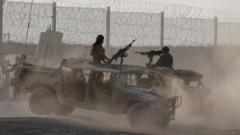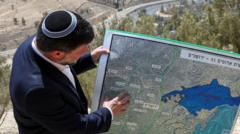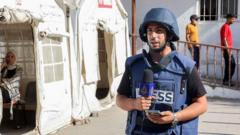A new aid initiative backed by the US and Israel, designed to combat hunger in Gaza, has faced severe backlash and chaos, marked by disorganized operations and armed security oversight.
Chaos Erupts as US-Israeli Funded Gaza Aid Program Faces Backlash

Chaos Erupts as US-Israeli Funded Gaza Aid Program Faces Backlash
The launch of a contentious aid distribution plan in Gaza has devolved into chaos amid armed security presence and chaotic scenes as desperate civilians seek assistance.
The scene on Tuesday at a Gaza aid distribution center was initially jubilant as armed contractors watched thousands of Palestinians respond to a call for unity. However, within hours, the atmosphere shifted dramatically as chaos erupted. Videos captured civilians trampling over barricades amid the sounds of gunfire, signaling a turbulent debut for the Gaza Humanitarian Foundation (GHF), a body backed by both the US and Israel.
GHF's mission aims to provide food supplies to the nearly two million Gazans at risk of starvation due to an Israeli blockade preventing fresh aid for over two months. The foundation is attempting to bypass traditional UN-led aid, a move that has faced widespread condemnation and boycott from various aid organizations, who argue that it undermines the existing humanitarian framework. Israel justifies the necessity of this new approach by claiming that Hamas has been stealing aid, an allegation the group denies.
Initial reports suggest GHF intended to distribute food to one million Gazans within its first week through four designated centers. However, confusion arises as claims of two million meals distributed within the first few days remain unverified. Eyewitness accounts and videos depict scenes of desperation, including instances where contractors resorted to using “non-lethal deterrents” to manage crowds, raising questions about the safety and efficacy of the aid provided.
The chaotic scenes at GHF distribution points have prompted criticism from existing aid organizations like Oxfam, citing a lack of accessibility for vulnerable populations and the militarized environment surrounding the aid operations. Observers point out the operational challenges of distributing humanitarian aid in such tense settings, suggesting it’s done more effectively with community cooperation rather than security force intervention.
As concerns mount regarding misinformation proliferating on social media about aid status, residents report relying on word of mouth amidst confusion. The lockdown of distribution sites due to looting incidents has further complicated the situation, with multiple aid organizations, including the World Food Program, acknowledging the deteriorating state of humanitarian access in Gaza.
As of Friday, reports indicated that only one of the GHF sites was active, briefly opening before announcing that supplies had run out. Many Gazans, after waiting in lines, left empty-handed, echoing the frustrations felt across the community as they face a dire humanitarian crisis with limited means of assistance.



















